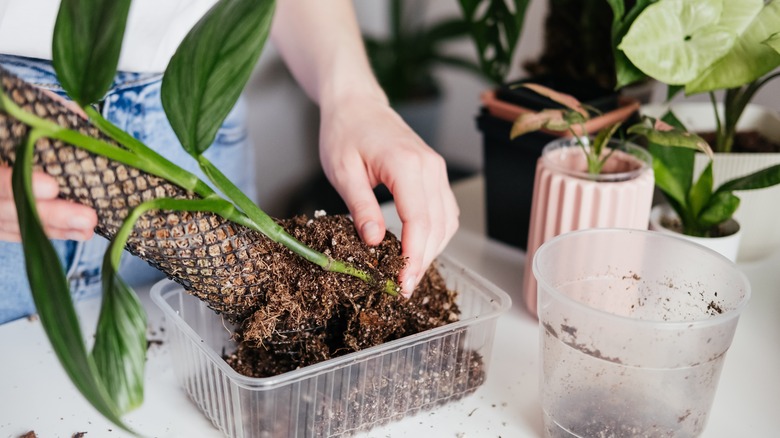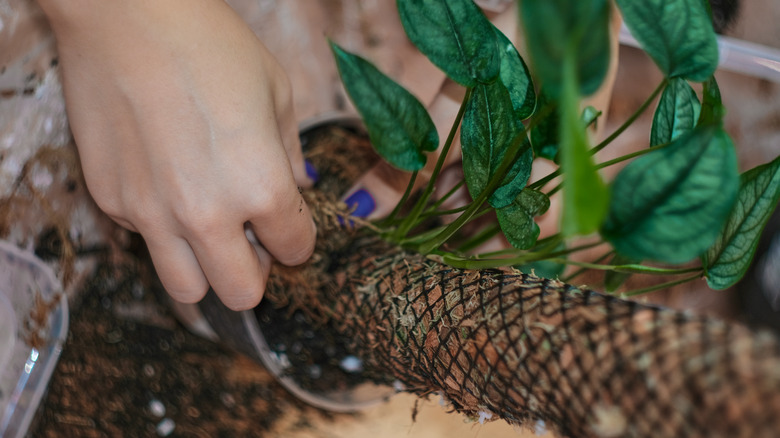DIY A Moss Pole For Healthy Indoor Houseplants With This Simple PVC Hack
We may receive a commission on purchases made from links.
Indoor plants are more than just green decorations. These living, breathing beings are friends, bringing better air quality and even helping to quell stress and anxiety for some. If you like finding ways to help your leafy loves grow, creating a DIY moss pole could be the ultimate form of care for your plants. This tool allows them to thrive and get the sustenance they need to give you their all.
The uninitiated might wonder what a moss pole is and why houseplants need one. A moss pole is a rod or PVC pipe wrapped in sphagnum moss. Its purpose is to mimic the natural texture of mossy bark and support the upright growth of climbing houseplants. Moss can be used in hanging baskets and other areas to provide proper drainage and an ideal environment for foliage. Just beware: These poles might make you forgo basic pots forever after seeing how cool and functional they are.
There are a few disadvantages to moss poles, though, like constant maintenance and the cost of supplies. However, some pros include larger leaves. These out-of-the-box holders are closer to many plants' natural habitats, ensuring they get optimum growing conditions with only a little work on your end. Ready to try it out? You only need a few supplies (unless you decide to make so many moss poles that your home becomes a replica forest, which is also totally fine).
Combine moss with your PVC pipe and mesh
Moss looks whimsical, and the benefits it brings to your indoor plants are invaluable. Sphagnum moss, in particular, is ideal for planting and growing some aroid plant species, and any that utilize aerial roots will work on a moss pole. This base provides your plants with nutrients and pulls in water and light, holding it so your leafy friends can absorb it through their aerial roots attached to the moss. To create a nutrient-dense nest for your plants, you want to start by collecting a PVC pipe that will be your core or anchor, which you can cut to any length you want, depending on how tall or short you intend the moss pole to be.
You will also need a wire mesh, moss (Sphagnum is great for a variety of plants like Besgrow's New Zealand Sphagnum Moss on Amazon), and some zip ties to hold the pillar together. Once you cut down your PVC pipe using a power miter saw or pipe cutter, trim your mesh with wire cutters to a smaller size that can wrap around the PVC. You won't need much in the way of width, and the length should allow your pipe to have enough on the bottom to stick into a pot without burying the moss. If you find your mesh overlaps too many times when you wrap it around the moss and pipe, trim more off the end so you don't have much excess wire.
Secure your pole and insert your stems
As the TikTok video demonstrates, fill a large container with water and soak the moss until it absorbs the moisture. After a few minutes, discard the excess water and squeeze the moss to remove the rest. Lay the mesh wire flat on the ground and cover it with moss vertically, leaving a few inches empty on the horizontal edges. Put your PVC pipe on top of this layer, then cover that with another coating of moss.
Pull the edges of the mesh wire around the moss and PVC, so you're left with a cylinder shape, wrapping it tightly. You want to be able to add stems into the mossy interior, so it needs to be compact enough to hold them but loose enough that the foliage can be inserted. Secure the top of the mesh wire by fastening it with zip ties, then trim any excess length.
Lastly, fill a medium plant pot with soil and perlite. Miracle-Gro Perlite on Home Depot is a great option. Fill the pot halfway with these and some orchid bark on top, which helps with drainage. Insert your moss pole and add your propagated stems. Monstera, Ivy, Orchids, and Hoyas will all do well in this easy DIY holder. Use greening pins, like Panacea's Greening Pins on Walmart, to train your hanging plants to grow in certain directions and keep them from pulling the pole over.

